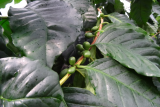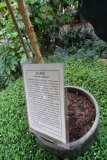Additional notes (click to expand)
Medicinal
Prescription only medicine: theophylline. It is the main source of caffeine commercially, used as a stimulant. Mildly addictive.
Coffea arabica. Caffeine and theophylline. Camellia sinensis. When the habits of drinking coffee made from berries of Coffea arabica and tea made from C. sinensis leaves became established in Europe in the 17th century, it was soon realised that they could cause the production of more urine than the volume drunk. It took more than 200 years to understand that both contained simple chemicals Theophylline and Caffeine that acted on the kidney to increasing the production of urine, diuresis. This used to be medically important because the effect could be used to treat diseases arising from failure of normal control of the water in the body such as in heart failure. Nowadays other, more powerful diuretics are available and both drinks are enjoyed for other reasons.
William Harvey and plant derived medicines currently used in cardiovascular medicine, Prof Michael de Swiet's Notes 2018
Sir Francis Bacon wrote of coffee in 1624 in his Sylva Sylvarum: "They have in Turkey, a Drinke called Coffa, made of a Berry of the same Name, as Blacke as Soot, and of a Strong scent, but not Aromaticall, which they take, beaten into a Powder, in Water, as Hot as they can Drinke it: And they take it, and site at it, in their Coffa-Houses, which are like our Tavernes. This Drinke comforteth the Braine, and Heart, and helpeth Digestion."
Keynes, G. (1978). The Life of William Harvey. Open University Press. p.406
Nomenclature
Arabica coffee is a hybrid species, formed by the hybridization of Coffea eugenioides and Coffea canephora. It is one of the only species in the genus Coffea that is self-fertile (autogamous), a single plant being able to produce fertile seed from its own pollen.
Other use
Coffee is one of the world's favourite drinks, one of the most important commercial crop-plants, and the second most valuable international commodity; Arabica coffee is considered to produce the finest coffee beans.
Royal Botanic Gardens, Kew. 2017. Coffea arabica [online] http://www.kew.org/science-conservation/plants-fungi/coffea-arabica-arabica-coffee
link
William Harvey (the first known physician to describe completely, and in detail, the systemic circulation and properties of blood) was an early adopter of the coffee habit , even before it came into general use with opening of the first coffee house in London in the early 1650s, as his brothers were merchants in the Levant Company and therefore able to import beans from 1616. John Aubrey found this worth remarking upon in his Brief Lives: “I remember he was wont to drink coffee: which he and his brother Eliab did, before Coffee-houses were in fashion in London”.
Keynes, G. (1978). The Life of William Harvey. Open University Press. pp.406-7
Geographical distribution
- Africa, Northeast Tropical Africa, Ethiopia
- Africa, Northeast Tropical Africa, Sudan
Coffea arabica L.
Family: RUBIACEAEGenus: Coffea
Species: arabica L.
Common names: Arabica coffee
Distribution summary: Africa
Habit: Shrub
Hardiness: H1b - Heated greenhouse; subtropical
Garden status: Currently grown
Garden location: Plants in pots (POT)
Reason for growing: Medicinal, other use, prescription only medicine

.JPG)
.JPG)
